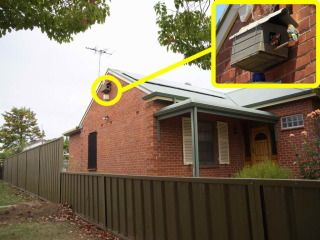You are here
Home ›Nest Boxes
Did you know it takes over 100 years for a tree to form natural hollows? In suburbia, by the time a tree gets old and large enough for this to happen, they are removed as they can be dangerous. Natural hollows are used by many different types of birds like parrots, kookaburras and pardalotes. Nest boxes may be a viable alternative to these hollows and are a great way to observe birds in all their life stages in your garden. To see just how important nest boxes can be, see our case study on the Confused Kookaburras
What is a nest box?
A nest box (or nestbox) is a box built especially for animals to nest in. Nest boxes are usually built for particular species of birds, but some mammals (e.g. possums) may also use them. A nest box is sometimes called a 'birdhouse', but this is not quite right - birds only use them to make their nests in during breeding season, not as a more permanent shelter or home.
Will I attract many birds by putting up a nest box?
All birds have very particular requirements when it comes to nesting and breeding, so just putting up a nest box to attract birds to nest in your garden, probably won't work. Also, the small number of birds that usually nest in tree hollows will be the only species that successfully nest in a nest box. Most other little birds build their own nests in thickets of shrubs and dense understorey plants.
Different birds require different shaped boxes. For nest box dimensions for a range of birds and the heights at which they must be placed, download the pdf on the right of this page.
Are nest boxes really necessary?
If you want to provide a nest box for a particular species, it is best to check with the Environmental Officer of your Local Government Authority that this species needs your assistance, before you put in your bird box. For example, there are many Rainbow Lorikeets living in the Sydney region and, although they are beautiful and fun-loving birds, too many of them create problems for other birds. So, rather than providing these already abundant birds with a nest box, it would be better to attract other less fortunate birds by planting thickets for them to nest in. Try putting up a nest box for small parrots, pardalotes, owls or nightjars instead of the usual large parrot box.
Nest boxes need to be planned carefully
Nest boxes require care and vigilance. Having a nest box isn't just about putting up a box and forgetting about it. Sometimes other species can move in, such as bees, Common Starlings or Common Mynas, which need to be evicted. There are designs available that can exclude some of these unwanted intruders.
So, if you do want to provide a suitable nest box for the right bird species, make sure you do some research first!
Some general tips:
- Face the nest-box away from prevailing winds. This usually means they should face north-east and place them out of the direct midday sun. Also ensure the box is waterproof and drill drainage holes in the bottom.
- Place tree-guards or exclusion collars around branches around the nest box to stop cats and rats reaching the box.
- Secure mesh on the inside from the opening to the floor. This gives the baby birds something to grip onto when they are ready to climb out of the nest.
- Be aware of invasion! Feral honeybees as well as introduced birds like the Common Myna and Common Starling will often try and set up home in a nest box. Make sure you have easy access to your nest box and can destroy honeybee nests or remove the nesting material and eggs of introduced birds. In some cases these birds can be persistant so you may need to do this multiple times.
- Monitor your nest box. Record usage, breeding success or failure, predation or aggression by introduced birds. Building up a data set over seasons and eventually over years provides invaluable information on the breeding success of native birds in suburbia. This can be submitted to your local bird club, local council or BirdLife Australia branch who will gladly accept data.
- When birds start to use the box, keep your distance. They are most likely to abandon a nest when still constructing it. Resist the urge to check inside and leave them to do their thing.
- Don't be afraid to think outside the box. The nest box below was attached to the house as the owner didn't have a tree to put it in. Eastern Rosellas happily moved in and raised young. Thank you to Allan Dent for his fantastic photograph.










